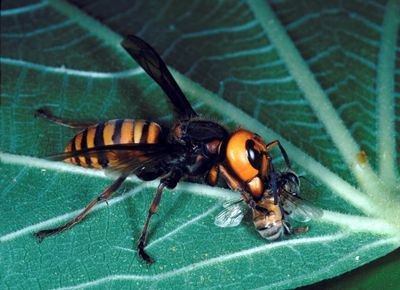Interactions
The Vespa mandarinia have been known to attack beehives and be quite aggressive (Matsuura and Sakagami 1973). While a V. mandarinia is hunting, an individual can kill up to 40 European Honey Bees in one minute. If around 25 V. mandarinia all attack at once, they can kill up to 30,000 European Honey Bees in three hours (Pollard 2005). To begin their attack, the hornets will approach the nest and wait for a counter attack. After checking for an attack, they will go inside and kill the bees within the hive. Following the killing of the bees, they prepare a meat ball of the bees killed (Matsuura and Sakagami 1973). The meat ball that the hornets prepare is a ball shaped pile of the dead honey bee mesosomas or the dead larvae. They also do this when they defend their own nest; one example being if some visiting Vespa mongolica got too close to the V. mandarinia’s nest, they would be chased away (Matsuura and Sakagami 1973). If the V. mongolica was caught, the V. mandarinia would kill it and form it into a meat ball. V. mandarinia aren’t the most agile of insects, so most of their protein comes from the caterpillars and large web spiders they prey on (Matsuura and Sakagami 1973). The V. mandarinia kills its prey by biting it to death with its strong mandibles or using its powerful stinger. Asian Giant Hornets tend to attack in groups, but they do not work together. Each individual works on its own to kill the bees from the hive and put the mesosoma in a pile near the hive. After most of the bees are killed, the V. mandarinia occupy the hive and bring the mesosomas of the pupae and larvae to the nest (Matsuura and Sakagami 1973). The only hornet species to have large amounts of predation on social bees is the V. mandarinia (Igarashi et al. 1995).
A
single honey bee has little to no chance of defending
itself because its lone sting is not enough to penetrate the
hornet’s cuticle (Pollard 2005). One of the honey bee’s only ways to
defend itself is to fly away because it is more agile than the
hornet. The Japanese Honey Bee has coevolved with the V. mandarinia
in order to keep up its defenses against the hornets (Igarashi et
al. 1995). The Japanese Honey Bees can sense the pheromone left
behind by the V. mandarinia. (Igarashi et al. 1995;
Pollard 2005). This pheromone allows them to prepare for a return
attack. Japanese Honey Bees get about one hundred of them to
surround the entrance for when the hornet comes back (Pollard 2005).
Once the hornet is drawn into the nest, around one thousand bees
meet it at the entrance and engulf the hornet by surrounding it
(Pollard 2005). The temperature inside the quivering ball of bees
reaches around 47°C for around twenty minutes. This high temperature
kills the V. mandarinia because hornets usually die around
44°C-46°C, but to kill the Japanese Honey Bee the temperature would
need to reach around 50°C (Pollard 2005).
The V. mandarinia doesn't have many natural enemys
to worry about, but there is one that can do quite a bit of damage.
The Xenos moutoni is one of the few natural enemies to the
hornets. This little parasite tends to infect many of the
immature hornet workers, developing within them as the hornet grows.
The parasite causes the V. mandarinia to lose
their reproductive abilities. This can cause colony numbers to
deplete if the parasite spreads rapidly throughout the colony.
Unfortunately for the V. mandarinia, the X. moutoni
is commonly found in the same reigons as them (Makino 2011).
Reproduction
Facts
Home Page
References

